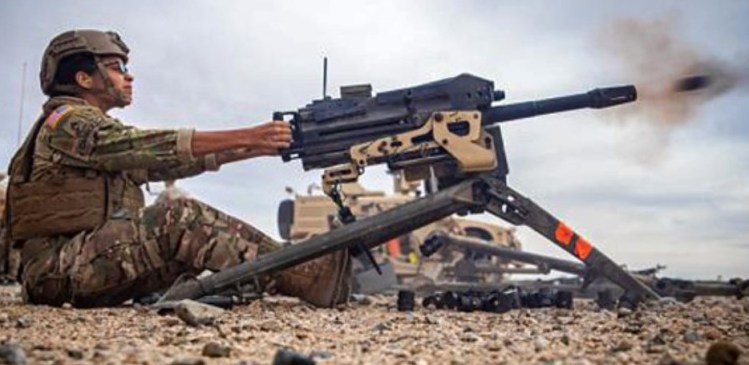The video below really took me back. This is the first time in years I’ve seen an actual Army instructor go through instructions on how to operate a specific weapons system.
If you’ve never been in the Army before, this is exactly how you’re taught in the field. Down and dirty. You can tell that the instructor is an expert and has done this many, many times. In this case, SSG Rodriguez walks us through the fundamentals of how to operate a Mark 19 Grenade Launcher. You might also hear this referred to as a Mark 19 Grenade Machine Gun. Either way, it is the same weapon.
Check out the video below, and we’ll continue.
SSG Rodriguez demonstrates the proper procedures for operating a Mark 19 grenade launcher. U.S. Army video by Sgt. Laurie Ellen Wash
Sergeant Rodriguez really knows his stuff. The U.S. military has long been known for its technological superiority, with weapon systems designed to give troops the upper hand in any engagement. Among the most formidable tools in the arsenal is the Mark 19 grenade launcher, an automatic, belt-fed weapon that brings heavy firepower to both offensive and defensive operations. From its development in the 1960s to its continued use today, the Mark 19 has proven itself as an indispensable asset in ground combat.
A Brief History of the Mark 19
The Mark 19 was first introduced during the Vietnam War. It was developed to provide soldiers with a portable, high-rate-of-fire weapon capable of firing explosive rounds. While early prototypes showed promise, it wasn’t until the Mark 19 Mod 3 that the weapon saw widespread use. By the 1980s, it had become a staple in the U.S. military’s arsenal.
Unlike traditional machine guns (yes, this is technically a machine gun), which primarily fire bullets, the Mark 19 uses 40mm grenades, giving troops the ability to deliver devastating explosive firepower at ranges of up to 2,200 meters. Its ability to suppress enemy forces from a distance, destroy light vehicles, and clear fortified positions makes it a unique force multiplier.
The video below really took me back. This is the first time in years I’ve seen an actual Army instructor go through instructions on how to operate a specific weapons system.
If you’ve never been in the Army before, this is exactly how you’re taught in the field. Down and dirty. You can tell that the instructor is an expert and has done this many, many times. In this case, SSG Rodriguez walks us through the fundamentals of how to operate a Mark 19 Grenade Launcher. You might also hear this referred to as a Mark 19 Grenade Machine Gun. Either way, it is the same weapon.
Check out the video below, and we’ll continue.
SSG Rodriguez demonstrates the proper procedures for operating a Mark 19 grenade launcher. U.S. Army video by Sgt. Laurie Ellen Wash
Sergeant Rodriguez really knows his stuff. The U.S. military has long been known for its technological superiority, with weapon systems designed to give troops the upper hand in any engagement. Among the most formidable tools in the arsenal is the Mark 19 grenade launcher, an automatic, belt-fed weapon that brings heavy firepower to both offensive and defensive operations. From its development in the 1960s to its continued use today, the Mark 19 has proven itself as an indispensable asset in ground combat.
A Brief History of the Mark 19
The Mark 19 was first introduced during the Vietnam War. It was developed to provide soldiers with a portable, high-rate-of-fire weapon capable of firing explosive rounds. While early prototypes showed promise, it wasn’t until the Mark 19 Mod 3 that the weapon saw widespread use. By the 1980s, it had become a staple in the U.S. military’s arsenal.
Unlike traditional machine guns (yes, this is technically a machine gun), which primarily fire bullets, the Mark 19 uses 40mm grenades, giving troops the ability to deliver devastating explosive firepower at ranges of up to 2,200 meters. Its ability to suppress enemy forces from a distance, destroy light vehicles, and clear fortified positions makes it a unique force multiplier.
Specifications and Capabilities
The Mark 19 is a belt-fed, blowback-operated weapon, meaning it uses the force of the recoil to automatically cycle through rounds, giving it a sustained fire capability. Here are the key specifications:
Caliber: 40mm grenades
Rate of Fire: 325 to 375 rounds per minute
Maximum Range: 2,212 meters
Effective Range: 1,500 meters for point targets, 2,212 meters for area targets
Weight: 77.6 pounds (without tripod)
Ammunition: The Mark 19 fires a variety of 40mm grenades, including high-explosive dual-purpose (HEDP) rounds, training practice rounds, and armor-piercing rounds.
Tactical Use and Versatility
One of the Mark 19’s key strengths is its versatility. Mounted on Humvees, MRAPs, and other vehicles, it is a primary defensive weapon in convoy operations and perimeter defense. In urban warfare, the ability to deliver indirect fire over buildings or into fortified positions makes it ideal for close-quarters combat, suppressing enemy forces hiding in cover.
On the battlefield, the Mark 19’s HEDP rounds can penetrate 2-inch thick armor while simultaneously delivering shrapnel over a wide area. This makes it effective against light vehicles, enemy combatants in cover, and even against certain armored vehicles. Infantry units often employ the weapon to provide cover fire for advancing troops or to secure defensive positions against enemy assaults.
Training and Maintenance
Operating the Mark 19 requires specialized training. While the basic mechanics of loading and firing the weapon are straightforward, gunners must be proficient in target acquisition, range estimation, and understanding the ballistics of the 40mm grenade. The arcing trajectory of the rounds can be challenging, especially in fast-paced combat situations, but with proper training, gunners can become highly effective at using the weapon in a variety of scenarios.
Maintaining the Mark 19 is also critical. Like any automatic weapon, it requires regular cleaning and care to ensure proper operation in harsh conditions. Dust, sand, and mud can quickly cause jams or misfires, making regular maintenance a priority for any unit relying on the weapon in the field.
The Mark 19 in Modern Conflicts
The Mark 19 has seen extensive use in Iraq, Afghanistan, and other theaters of war where the U.S. military has been engaged. Its ability to engage enemy positions from long distances while staying out of the effective range of most small arms has made it invaluable in urban and desert environments alike.
In recent years, the Mark 19 has also been integrated into special operations. U.S. Navy SEALs and Army Special Forces have used it in a variety of missions, from defending forward operating bases (FOB) to mounting it on riverine patrol boats for coastal and riverine warfare.
Challenges and Future Developments
Despite its effectiveness, the Mark 19 is not without its limitations. Its weight and bulk make it impractical for dismounted infantry operations, and its rate of fire can quickly lead to ammunition depletion. Furthermore, the weapon’s effectiveness can be reduced in dense environments, where trees, buildings, or other obstacles may hinder the arcing trajectory of the grenades. Operators must be creative and judicious in their use of this weapon.
As the military continues to modernize its forces, there have been discussions about developing lighter, more efficient automatic grenade launchers. Some prototypes aim to reduce the weight while maintaining the firepower the Mark 19 delivers. However, for the foreseeable future, the Mark 19 remains a cornerstone of U.S. military firepower.
Summing Up
The Mark 19 grenade launcher has been a critical part of the U.S. military’s firepower for over half a century, providing infantry units and vehicle crews with unparalleled explosive capability. Its versatility, range, and sheer destructive power make it a weapon that can dominate the battlefield, providing offensive and defensive support in any engagement. As warfare continues to evolve, the Mark 19 will undoubtedly remain a reliable tool for U.S. forces, solidifying its legacy as one of the most formidable weapons in the military’s arsenal.
—
Disclaimer: SOFREP utilizes AI for image generation and article research. Occasionally, it’s like handing a chimpanzee the keys to your liquor cabinet. It’s not always perfect and if a mistake is made, we own up to it full stop. In a world where information comes at us in tidal waves, it is an important tool that helps us sift through the brass for live rounds.



